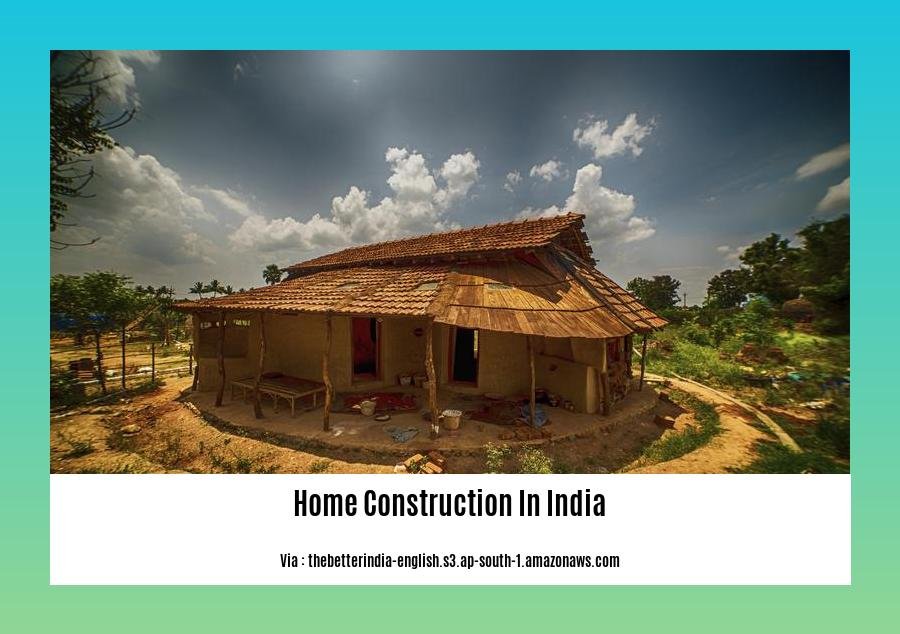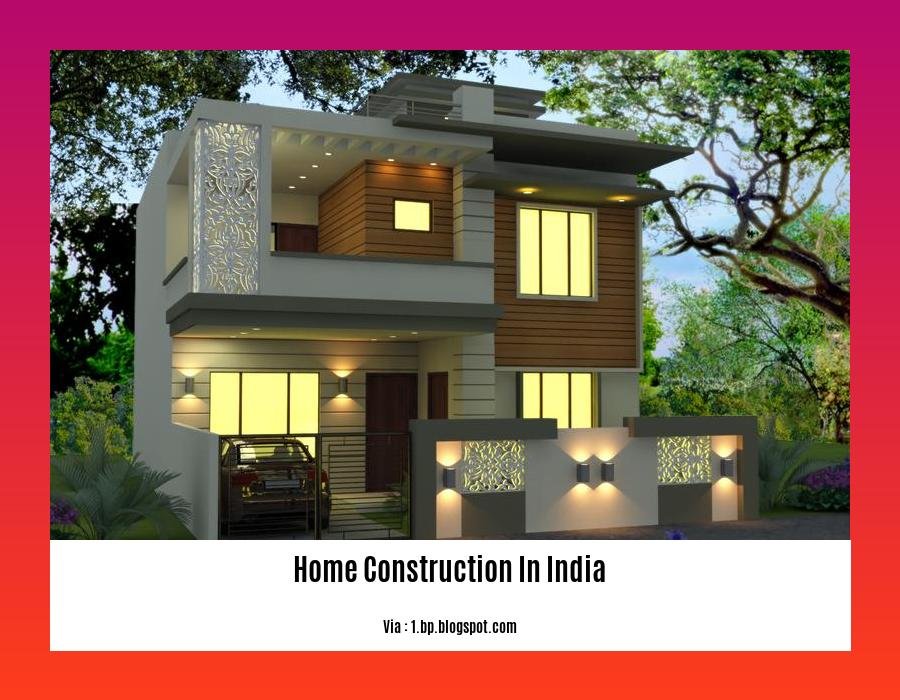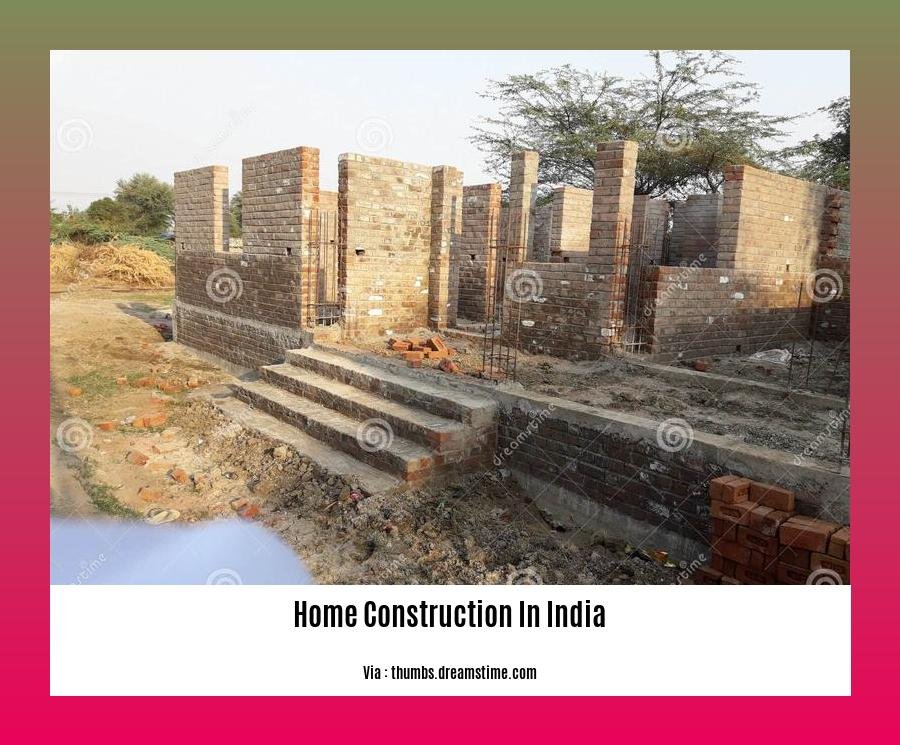Embark on a comprehensive journey of residential construction in India with our Essential Guide to Home Construction in India. This detailed resource delves into every aspect of the process, from selecting the perfect plot to navigating the complexities of construction costs. Whether you’re a seasoned homeowner or embarking on your first construction project, this guide equips you with the knowledge and insights to make informed decisions and create the home of your dreams.
Key Takeaways:
- Pre-construction: Test soil, secure permits.
- Excavation: Mark boundaries, lay foundation.
- Framing: Install walls, roof, windows, doors.
- Electrical, plumbing, HVAC: Run wires, pipes, install fixtures.
- Finishes: Paint, tile, floor, landscape.
Home Construction in India

Navigating the complexities of home construction in India requires a comprehensive understanding of local practices, building codes, and sustainable approaches. Here’s a step-by-step guide to help you construct your dream home efficiently:
Planning
- Secure land: Identify and acquire a suitable plot for your construction.
- Design and approvals: Create a detailed architectural plan that adheres to building codes and obtain necessary permits.
- Budgeting: Estimate construction costs, including labor, materials, and contingencies.
Construction
- Foundation and structure: Lay a strong foundation, erect the structure, and install windows and doors.
- Utilities: Install electrical, plumbing, and gas lines to ensure essential services.
- Interior finishes: Paint, tile, and floor the interior spaces according to your design.
- Exterior finishes: Choose roofing, siding, and landscaping that complement the architecture and local climate.
Sustainability
- Energy efficiency: Incorporate energy-saving technologies, such as solar panels, energy-efficient appliances, and insulated walls.
- Water conservation: Install low-flow fixtures, rainwater harvesting systems, and drought-tolerant landscaping.
- Waste reduction: Use sustainable building materials, recycle construction waste, and minimize site disturbance.
Cost Considerations
- Material selection: Choose materials that are cost-effective, durable, and locally available.
- Labor costs: Factor in labor costs, which vary based on region and skill level.
- Government incentives: Explore government subsidies and tax benefits to reduce construction expenses.
Local Expertise
- Hire a qualified architect: Engage an experienced architect who understands Indian building practices and regulations.
- Consult local contractors: Partner with reputable contractors who have a proven track record in home construction in India.
- Research local building codes: Familiarize yourself with the specific building codes and zoning regulations in your area.
Timeline and Management
- Set realistic timelines: Plan a realistic construction schedule to avoid delays.
- Monitor progress: Regularly inspect the construction site and communicate with contractors to ensure quality and adherence to the plan.
- Address challenges: Anticipate and address potential challenges during construction, such as weather issues, material shortages, or design revisions.
By following these steps and leveraging local expertise, you can ensure a successful and sustainable home construction in India. Remember, building a dream home should be an enjoyable and rewarding experience!
Unleash the potential of your next home construction project with our comprehensive home construction material calculator and home construction material list.
Alternatively, if you’re exploring the realm of industrial construction, connect with a network of trusted plant construction companies, ensuring a seamless and efficient project execution.
How to choose a plot for home construction?

Choosing the right plot is crucial for hassle-free home construction. Let’s dive into the key factors to consider:
1. Type of Plot:
Deciding on the type of plot is essential. In India, you’ll find residential, commercial, agricultural, and industrial plots. Choose based on your needs and the intended purpose of the construction.
2. Locality:
The location of the plot significantly influences its value and desirability. Factors like proximity to essential amenities such as schools, hospitals, and transportation hubs should be considered.
3. Essential Amenities:
Availability of essential services, including approach road, water supply, and electricity, is a must. Check if these amenities are readily accessible or if additional arrangements are required.
4. Legal Verification:
Thoroughly inspect the legal documents of the plot to ensure clear ownership and absence of any disputes or encumbrances. It’s wise to engage a lawyer for legal due diligence.
Key Takeaways:
- Assess the different plot types available in India and choose one that aligns with your purpose.
- Research the locality to determine its desirability and proximity to essential amenities.
- Verify the availability of essential services like water supply, electricity, and an approach road.
- Conduct a thorough legal verification of the plot’s ownership and documentation.
Relevant URL Sources:
- Construction Placements
- HouseYog
Factors Impacting Construction Cost per Square Foot
Introduction
Planning and budgeting for a home construction project in India requires a comprehensive understanding of the various factors that influence the cost per square foot. This guide explores the key considerations to help homebuyers make informed decisions and anticipate the overall expenses associated with their building endeavor.
Key Factors Affecting Construction Cost
-
Location: The geographic location of the construction site significantly affects costs due to variations in land prices, availability of materials, and labor rates. Urban areas typically have higher costs compared to rural regions.
-
Land Size and Topography: The size and shape of the land influence the cost of site preparation, excavation, and foundation work. Sloped or uneven terrain may require additional grading and retaining walls, increasing the overall expenses.
-
Building Materials: The choice of building materials directly impacts the construction cost. High-quality materials, such as imported marble or hardwood flooring, command a premium compared to standard materials like concrete or ceramic tiles.
-
Design Complexity: The architectural design of the house plays a crucial role in determining cost. Complex designs, such as curved walls, vaulted ceilings, and intricate facades, require specialized labor and materials, leading to higher expenses.
-
Labor Costs: The availability and skill level of construction workers influence labor costs. In regions with a shortage of skilled labor, contractors may charge higher rates.
-
Permits and Approvals: Obtaining necessary building permits and approvals from local authorities is essential. The cost of these permits and the time required to acquire them can vary depending on the location and project scale.
-
Utilities and Infrastructure: Connecting the house to essential utilities, such as electricity, water, and gas, requires additional costs for materials, installation, and inspection fees.
-
Time of Year: Seasonal factors, such as monsoon rains or extreme heat, can affect construction schedules and material availability, potentially leading to cost overruns.
-
Contingency Fund: It is prudent to allocate a contingency fund of approximately 10-15% of the total budget to cover unexpected expenses, such as unforeseen site conditions or material price fluctuations.
Conclusion
Understanding the factors that impact construction cost per square foot enables homebuyers to make informed financial decisions and plan accordingly. By carefully considering these factors and consulting with experienced professionals, individuals can estimate their project costs accurately and minimize potential surprises or budget overruns.
Key Takeaways:
- Location, land characteristics, and building materials significantly impact construction costs.
- Design complexity and labor availability influence expenses.
- Permits, approvals, and utility connections are essential cost factors.
- Seasonal factors and contingency funds should be considered for accurate budgeting.
FAQ
Q1: What are the key steps involved in house construction in India?
A1: House construction in India follows a step-by-step process that involves site preparation, foundation laying, structural framing, utility installation, interior and exterior finishes, and final inspections.
Q2: How much does it cost to build a house in India?
A2: The average cost of construction in India varies depending on factors such as location, size, and materials used. However, on average, it ranges from Rs 1,300 to Rs 5,000 per square foot.
Q3: What are the factors to consider when choosing a plot for home construction?
A3: When selecting a plot for home construction, it’s important to consider factors such as the locality, essential amenities like water and electricity, legal documentation, and proximity to essential infrastructure.
Q4: How have recent events impacted construction costs in India?
A4: Recent events such as the COVID-19 pandemic and the Russia-Ukraine crisis have affected construction costs in India. These events have led to disruptions in the supply chain, increased material prices, and labor shortages.
Q5: What are the common types of construction contracts used in India?
A5: The two common types of construction contracts used in India are labor-only contracts, where the homeowner is responsible for material procurement, and material plus labor contracts, where the contractor handles both materials and labor.
- Kitchen Counter Corner Ideas: Style Your Awkward Angles Now - December 31, 2025
- Best Finish for Butcher Block Countertops: Choosing the Right Option - December 30, 2025
- Seal for butcher block: Find the best food-safe finish - December 29, 2025










